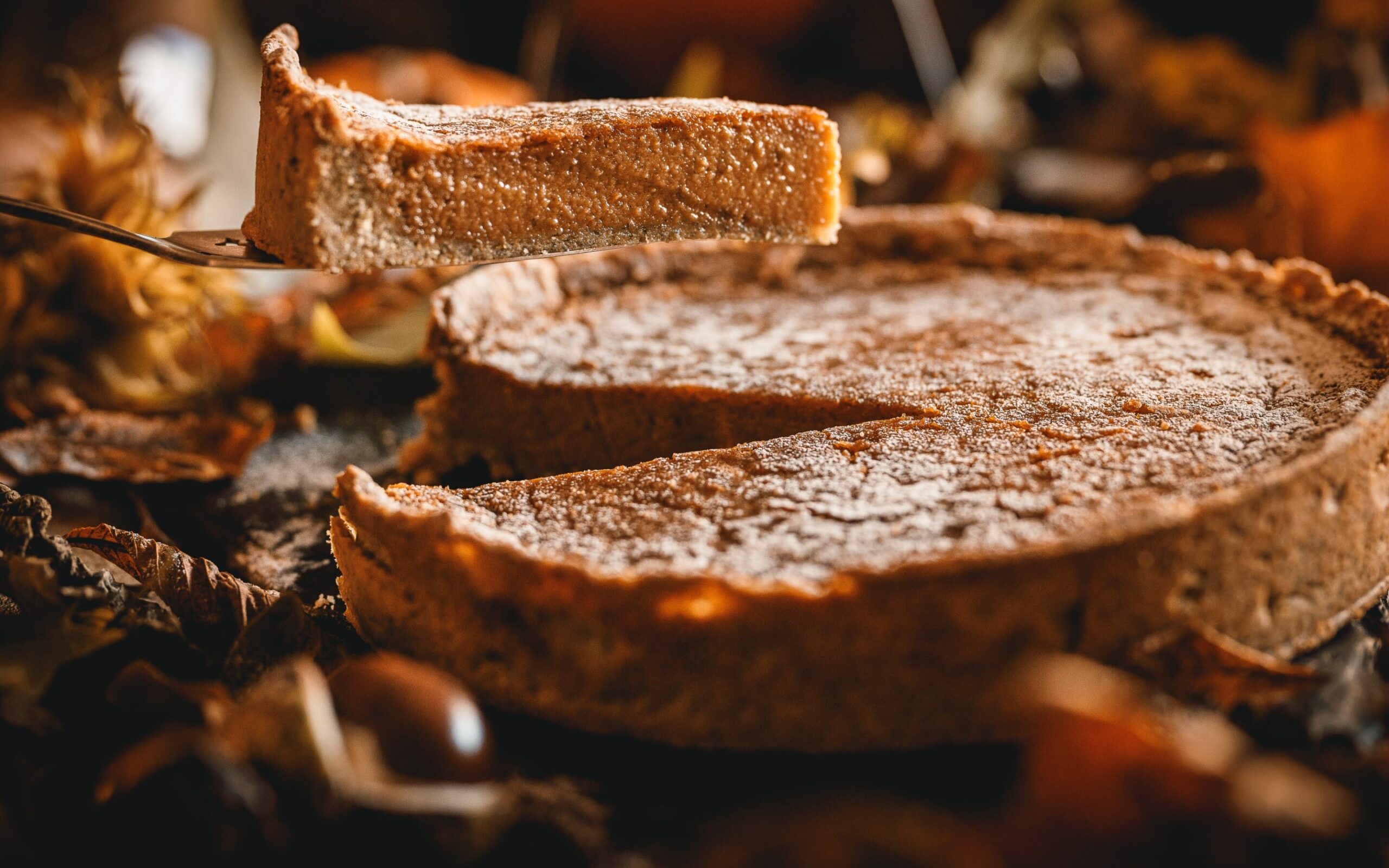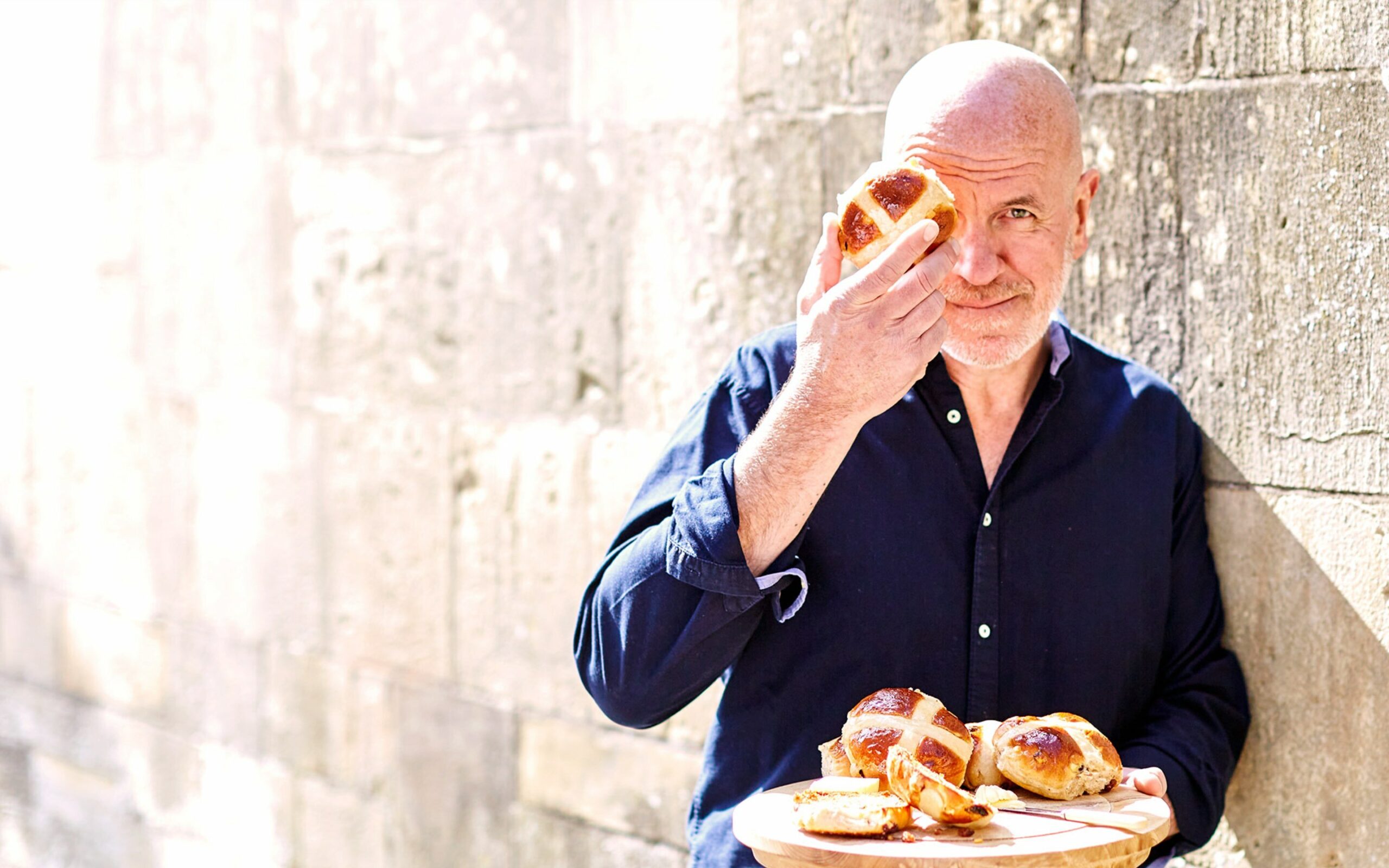
Looking to tie up Thanksgiving dinner on a mouth-watering high? Or simply want to try something sweet and seasonal this autumn? This homemade pumpkin pie recipe from baker Richard Bertinet should do just the trick.
What is pumpkin pie?
Pumpkin pie is a classic autumnal dessert. Made with a smooth pumpkin filling, flavoured with warm spices like cinnamon and nutmeg, and nestled in a flaky crust, it has become a traditional dish to enjoy around harvest time, every year.
The golden-brown pie, sometimes served topped with whipped cream, has become a famous Thanksgiving dessert, with around 50 million pumpkin pies being eaten each November in the US. It’s so popular in fact, that you’ll also find its influence on the menus of popular coffee chains when September comes around each year, hailing autumn the ‘pumpkin spiced latte’ season.
So, what makes it so special? Warm spices, a creamy filling and a buttery crust certainly have something to do with it…

How to make pumpkin pie
A good pastry crust is key to a great pumpkin pie. Whether you want to opt for store-bought pastry or make your own by hand with a mixer or food processor, Richard Bertinet’s delicious pumpkin pie recipe takes you through the process step by step. Inspired by his auntie Julia, it’s sure to become a favourite with your family too.
Pumpkin pie recipe
This recipe creates enough pastry and mixture to produce one pumpkin pie – ready for sharing – or six individual, small pies.

Ingredients
- 1 quantity of pastry for the pie crust (ingredients below)
- 4 eggs
- 75g (2.5oz) dark brown sugar
- 195g (7oz) caster (baker’s) sugar
- 425g (1 can) (15oz) unsweetened pumpkin puree
- ½ tsp salt
- 1 tsp ground cinnamon
- ½ tsp ground ginger
- ½ tsp ground allspice
- ½ tsp ground nutmeg
- ¼ tsp ground mace
- ¼ tsp ground star anise
- 30g (1oz) melted butter
- 330g (11½oz) double (heavy) cream
For the homemade pie crust:
- 50g (3½oz) pumpkin seeds, ground to flour in a cup blender, with larger pieces of seed sifted out
- 300g (10½oz) plain (all-purpose) flour
- 125g (4½oz) butter
- 1 whole egg and 2 egg yolks
- 125g (4½oz) caster (baker’s) sugar (optional)
- Pinch of salt
To make the pastry dough by hand
1. Measure out all your ingredients before you start. Break one egg into a small bowl – there is no need to beat it – and separate the remaining eggs.
2. Put the flour and salt into a large bowl. Take the butter straight from the fridge and place it between two pieces of greaseproof paper or butter wrappers, then bash it firmly with a rolling pin. The idea is to soften it, while still keeping it cold. You’ll end up with a thin, cold slab about a centimetre thick that bends like plasticine.
3. Put the whole slab into the bowl of flour. Cover the butter well with flour and tear it into large pieces. Now it’s time to flake the flour and butter together – this is where you want a really light touch.
4. With both hands, scoop up the flour-covered butter and flick your thumbs over the surface, pushing away from you, as if you are dealing a pack of cards. You just need a soft, skimming motion – no pressing or squeezing – and the butter will quickly start to break into smaller pieces.
5. Keep doing this, making sure all the pieces of butter remain coated with flour so they don’t become sticky. The important thing now is to stop mixing when the shards of butter are the size of your little fingernail.
“There is an idea that you have to keep rubbing in the butter until the mixture looks like breadcrumbs, but you don’t need to take it that far,” says Richard Bertinet. “Resist putting your hands back into the bowl to rub again – if you want a light pastry, it’s really important not to overwork it.”
While it’s still in the bowl, press down on the dough with both thumbs, then turn the dough clockwise a few degrees and press down and turn again. Repeat this a few times.
6. With the help of your spoon or scraper, turn the pastry onto a work surface and begin to work the dough. Hold the dough with both hands, press down gently with your thumbs, then turn the dough clockwise a few degrees, press down with your thumbs again and turn. Repeat this about four or five times in all.
Now fold the pastry over itself and press down with your fingertips. Provided the dough isn’t sticky, you shouldn’t need to flour the surface, but if you do, make sure you give it only a really light dusting, not handfuls, as this extra flour will all go into your pastry and make it heavier. Repeat the folding and pressing down with your fingertips a couple of times until the dough feels like plasticine and looks homogeneous.
7. Finally, pick up the piece of pastry and tap each side on the work surface to square it off so that when you come to roll it, you are starting off with a good shape rather than raggedy edges.

To make the pastry dough with a food mixer:
1. Put the flour and salt into the bowl of the machine. Bash the butter as described in the hand-mixing method, then break it into four or five pieces and add it to the flour.
2. Using a paddle attachment rather than a hook or whisk, mix the ingredients at a slow speed until the pieces of butter are about the size of your little fingernail. You will need to scrape the butter from the paddle a few times as it will stick. If you are making sweet pastry, add the sugar at this point and mix in well.
3. Add the egg(s), and yolk (if making sweet pastry) and water (if making salted pastry) and mix very briefly, until a dough forms. As soon as it does, turn it out onto your work surface with the help of your scraper and follow the hand-mixing method.
To make the pastry dough with a food processor:
It is very easy to overwork pastry in a food processor. Here’s how to do it right.
1. Put the flour and salt into the bowl of the machine. Cut the cold butter into small cubes and add to the bowl.
2. Use the pulse button in short bursts so that the flour just lifts and mixes, lifts and mixes. You don’t want to blitz everything into a greasy ball as that will result in hard, dense pastry. If you are making sweet pastry, add the sugar at this point and mix in well.
3. Add the egg(s), and yolk (if wanting to make a sweet pastry) and water (if opting for a salted pastry) – then pulse briefly until the pastry dough comes together.
4. Turn it out with the help of your scraper and follow the hand-mixing method.
5. When your dough is good to go, wrap it in greaseproof paper and leave it to rest in the fridge for at least an hour before using.
Note: the pastry dough can be kept for up to 10 days in the fridge or a few weeks in the freezer.

For the pumpkin pie filling:
1. Preheat the oven temperature to 160°C (320 F)
2. Roll your pastry out to 3-5mm thickness, using a little flour to ensure it keeps moving on the surface and is not sticky. Line a 25cm tart ring or case and cover with baking parchment and baking beans. Blind bake the case with the beans for 10-15 minutes. Remove the beans and return to the oven for another couple of minutes.
3. Combine all the filling ingredients in the order given, ensuring that the spices are well incorporated.
4. Pour the filling into the blind baked tart shell. Then bake for 45 minutes until set. If baking separate pies in smaller 10cm shells, bake for 20 minutes.
5. Remove the pie from the oven. Now, how can you tell if pumpkin pie is done? Here’s a tip: It should jiggle ever so slightly if you very gently shake the tin.
You may have excess pastry on the top or sides of the pie that you want to trim. To avoid waste, save any extra pastry and repurpose it into a cheesecake base or use it as a crumb on a different dessert.
You can let the pie cool to room temperature completely and when ready to serve, enjoy it topped with Chantilly cream, or simply on its own.
It will keep for up to two to four days when refrigerated. If it lasts that long…



Want to learn more about baking?
Sweet treats, spongey buns and airy doughs… Richard covers them all in his online baking course. Learn his tips, tricks and techniques to master the art of breadmaking.

Give the gift of knowledge
Surprise a special someone with a year's access to BBC Maestro or gift them a single course.